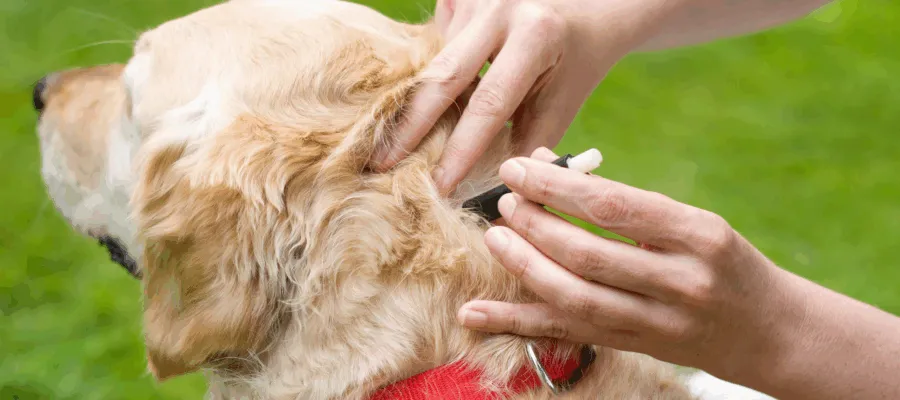Natural Remedies to Soothe Bug Bites on Dogs
Posted - July 20, 2025

By Carol Bryant, Professional Pet Blogger
Insect bites are more than a nuisance for our pets. Whether a mosquito bite on an evening walk, a bee sting while playing outside, or a flea reaction, bug bites on dogs can cause pain, discomfort, or worse. If your dog scratches or licks at the site, they may break the skin, enabling bacteria to enter, and leading to hot spots or infections.
My female Cocker Spaniel, Brandy Noel, stepped on a wasp a few years ago. She yelped in pain, so my dog mom instincts kicked in. Protruding from her paw was a stinger ripe for the picking. I yanked it out with my fingernails and called my veterinarian. He instructed me to give her a Benadryl tablet and clean it with warm water and soap. Thank goodness, she never had any other issues.
Bug bites on dogs are a big deal. While some dogs have minor reactions, others develop hot spots, swelling, itching, redness, or bumps at the site. In severe cases, dogs may experience hives, facial swelling, difficulty breathing, or anaphylactic shock.
In this article, we’ll explain signs of bug bites in dogs, natural remedies to soothe affected areas, and how to prevent bug bites naturally. If you ever have a concern, never wait to call your veterinarian, as every second counts if your dog has a severe reaction to a bug bite.
Signs of Bug Bites on Dogs
Some of the most common insect bites on dogs are mosquitoes, fleas, ticks, ants, bees, and spiders. Knowing the normal appearance and texture of your dog’s coat and skin is essential. Running your fingertips through your dog’s coat every night or after a walk ensures you can feel or see anything out of the ordinary.
These are some of the most notable signs of a bug bite on your dog:
- Redness and swelling at the impact site
- Scratching and itching (dogs may snap when touched if pain is involved)
- Raised lesions or lumps
- Limping if a paw or leg is involved
- Facial swelling, usually near the muzzle, eyes, or face, should be addressed immediately by calling your veterinarian or visiting a veterinary emergency room.
- Difficulty breathing or labored, heavy breathing, which is generally associated with an anaphylactic reaction
- Gastric symptoms like vomiting or diarrhea, which can occur with certain insect bites
- Pale gums (which happened with my second Cocker Spaniel after a tick bite) – his body was losing platelets
Pro Tip: When monitoring a possible bug bite on your dog, snap photos of the area. Continue to monitor it and show your veterinarian via text, email, or if a visit is in order.
Natural Remedies to Soothe Bug Bites on Dogs
For minor bites or stings, there are some natural remedies and things you can do at home to help ease your dog’s discomfort and pain.
I learned long ago how to treat bug bites on dogs, and my first line of defense is a well-stocked canine first aid kit. I keep one kit at home and take a smaller, but equally reliable one, with me for trips to the park or long weekends.
Within that pet first aid kit are several ZYMOX products. I trust ZYMOX for their LP3 enzyme system that doesn’t use harsh chemicals or antibiotics. Instead, they rely on naturally occurring enzymes to ward off bacteria, fungi, and yeast on the skin. Fortunately, ZYMOX products support a dog’s skin with a natural healing process and help reduce inflammation.
Here are my top tips for soothing your dog’s bug bite at home without harsh chemicals:
1. Use ZYMOX Topical Spray with 0.5% hydrocortisone: This handy spray bottle relieves itching due to minor skin irritations and inflammation. It provides itch relief and soothes hot spots, wounds, cuts, dermatitis, ringworm, and more. This is one of my favorite skin products for dogs.
2. Apply ZYMOX Topical Cream with 0.5% hydrocortisone: If you prefer a cream consistency, which I apply to different parts of my dog’s body, ZYMOX offers this product. This Cocker Spaniel mama applies it to body folds to prevent hot spots or bacteria from forming.
Fun Fact: ZYMOX offers a line of skin care products for dogs and cats without hydrocortisone if you prefer, as well as a topical skin cream and a topical spray with 1% hydrocortisone.
3. Don’t Use Hydrogen Peroxide: According to small animal veterinarian, Dr. Lindsay Butzer, “Peroxide can be way too harsh for pet wounds, causing them to get chemically burned and become even worse; go to your vet.”
4. Apply a Cold Compress: A cold pack applied with care may reduce swelling and numb the area, providing relief for your dog. Don’t leave it on too long, so it doesn’t burn the skin.
5. Oatmeal Soak: An oatmeal bath may help soothe irritated skin and inflammation. The ZYMOX Advanced Enzymatic Shampoo contains vitamin D3 and oat extract for sensitive skin.
Preventing Bug Bites Naturally
There are plenty of non-chemical pest repellents available to keep bugs away from your dog. Choose a bug repellent that is designed for dogs and never use human products, such as OFF!, which contains DEET and is dangerous to dogs. Be sure to look for flea bites, bee stingers, and any redness or swollen areas on your dog’s skin before and after applying dog-safe products.
Keep your dog away from standing water where mosquitoes congregate, avoid high grass where ticks thrive, and ensure your dog has a strong immune system to make them less appealing to bugs. Keep grass mowed in your yard and give your dog regular baths and grooming sessions.
Here are my favorite flea and tick preventatives without harsh chemicals. I don’t use them all at once, but rotate and check my dog’s skin and coat daily. As a bonus, here is our list of summer skin care secrets to keep your dog’s skin healthy in warmer months.
When To Seek Veterinary Intervention
If your dog consistently scratches or licks its skin, displays signs of pain, or if you notice facial swelling, difficulty breathing, excessive drooling, or vomiting, it’s best to call your veterinarian. If a possible bug bite occurs after hours, keep the name of your closest emergency clinic nearby in your phone with an address handy.
It’s always better to err on the side of caution than to try to self-treat at home, as some bug bite reactions may escalate quickly to an emergency. Be the pet parent your dog knows you are, and pay close attention to any new lumps, bumps, or signs of a bug bite.

